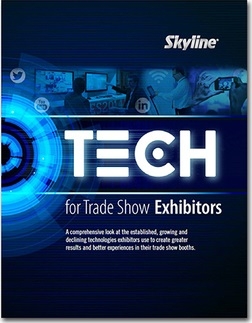Skyline Report Uncovers Exhibitor Technology Trends

Skyline Exhibits recently released a report, “Tech For Trade Show Exhibitor” that takes a look at the established, growing and declining technologies exhibitors are using based on recent survey results.
In the fall of 2014, Skyline surveyed 15,000 exhibitors in order to understand what technologies organizations are incorporating into their exhibit programs. The report is a summary of the 380 responses they received as a result of that survey.
Skyline found the majority of those surveyed have a positive perception of technology. Just more than 87 percent of exhibitors feel technology makes their trade shows more effective. However, 30 percent of respondents felt that technology is too expensive.
Tablet computers see the highest usage and growth rates in both interactive and non-interactive use. Fifty percent of exhibitors are currently using tablets non-interactively and two-thirds are using them interactively.
Touch screen monitors are also very popular with exhibitors with fifty percent using them or planning to use them in the next two years. Other technology usage that is expected to grow is video walls, translucent screens, and 4K resolution flat screens.
When it comes to lighting, the survey found that theatrical stage lighting and fluorescent lighting is becoming obsolete while LED lighting is expected to be an emerging trend.
Lead retrieval was another category the survey addressed. It is expected that close to two-thirds of exhibitors will be using a show provided mobile lead retrieval apps in the next two years. Currently only one in four exhibitors are using rented (not from the show) or company owned lead retrieval systems.
Facebook, Twitter, and LinkedIn are the most popular social media platforms with YouTube falling just behind those top three. Keep an eye out for more Instagram activity as 40 percent of respondents plan to start using it in the next two years.
Skyline also asked respondents about how they use apps to enable interaction with show attendees. While the most popular option was the show app, only one in five exhibitors are using it as part of their marketing. A third of the respondents indicated they were not aware these types of applications existed.
When Skyline broke the numbers down by industry, they found that tech companies buy into the show app at 35 percent while health care companies buy in at just 15 percent.
When asked about mobile technology, half the respondents indicated they had never heard of RFID or NFC. Only ten percent of exhibitors currently use either of those technologies or plan to use them over the next two years.
One-third of the exhibitors responding said they were currently using QR codes giving that technology the highest usage in the mobile technology category. Interestingly, QR codes also have the highest bail rate with 25 percent of exhibitors using them say they intend to stop.
Live polling and texting, while not widely used currently, is expected to grow with 15 percent of exhibitors intending to use those technologies in the next two years.
Wi-Fi Internet is being used by two-thirds of exhibitors and another 12 percent planning on using it in the near future. Hardwired Internet has a bail rate of about 20 percent and almost 45 percent of respondents say they have no plans on using it in the future.
Given the heavy presence of mobile devices at trade shows, 50 percent of exhibitors say they plan on incorporating mobile charging stations into their booths.
Overall, virtual events showed low usage and low growth rate except when broken down by industry. Almost 60 percent of exhibitors who identified as technology companies plan to incorporate virtual events into their exhibit strategy.
When exhibitors need help and information on technology, two-thirds say they turn to their internal IT department, and one-third turn to the show organizer or AV/tech vendors. Thirty percent of exhibitors responded ÒI do it all myself.Ó
The top four types of content being used on all this technology were company websites, presentations (PowerPoint, Keynote, etc.), play only video, and photos and illustrations. Thirty percent of exhibitors said they were using technology to do software demos. Least popular were interactive video content, 3D animation, and Motion-activated projection.
When it comes to paying for all this technology, 50 percent of exhibitors say they are spending up to ten percent of their budget on technology. Forty-two percent of exhibitors expect their tech budgets to grow, compared to only 5 percent who expect to see a drop.
The report also highlights exhibitorsÕ biggest tech challenges and the number one response was Internet access at trade shows. Exhibitors indicated cost as one aspect of that challenge. The poor quality of Wi-Fi provided by the venue or show organizer was an even bigger problem.
Another significant challenge was education and training on the technology. The report asks if trade show technology is too hard to use?
The Skyline report provides exhibitors a way to see where they stand in comparison to their peers. It also gives show organizers a glimpse into the mind of their exhibitors when it comes to technology. It is a thorough look at what technology exhibitors find obsolete and what technology they are eager to implement in the near future.


Add new comment